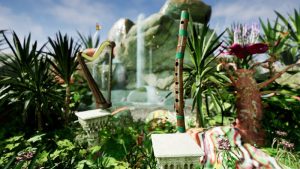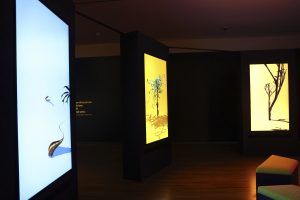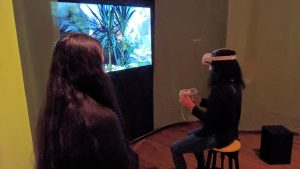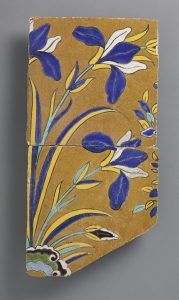Spending just part of a day in this particular garden introduces the visitor to a multimedia experience in which technology acts as a bridge between now and then, pessimism and optimism, between physical and virtual reality.

A VR video still from Shezad Dawood’s Night in the Garden of Love, 2023. The virtual reality environment was produced by and image used courtesy of UBIK Productions. Co-commissioned by WIELS, Brussels and Aga Khan Museum, Toronto.
Spending a Night in the Garden of Love, which is the title of a fascinating and first-of-its-kind art exhibition now at the Aga Khan Museum in Toronto, fully immerses the visitor in a digital realm of artistic, musical and technological interventions. It takes a few focused hours to take it all in: there’s a Virtual Reality environment navigated by head- and hand-set; there’s a multiscreen Digital Seedbank that grows before one’s eyes, and there’s a unique exhibition scent, created using Artificial Intelligence, to engage one’s nose. (One should not touch, but there are gorgeous tapestries and textile creations in the exhibit as well, hanging in the spaces between the tactile and the virtual.)
So all the human senses are involved, and lots of advanced technology, too. VR, AI, networked gaming PCs, giant sequenced high-res video monitors, pro soundbars and more.

Contemporary artist Shezad Dawood (right) uses gardens as a starting point for creative, futuristic, and intercultural conversations in an exhibition inspired by African-American Muslim musician and composer Dr. Yusef Lateef and his cli-fi novella, Night in the Garden of Love (1988). (Image: Dr. Yusef Lateef. Photo Credit: Michael Di Donna).
The exhibition is a collaborative creation among many artists, technologies and disciplines: it’s spearheaded by contemporary artist Shezad Dawood, who’s based in the U.K. (London is his hometown and working base). He’s a Senior Research Fellow in Experimental Media at the University of Westminster, and a multidisciplinary artist whose work often mashes up painting, textiles, sculpture, dance, film, and digital media. Dawood adds a philosophical bent to his work, and he’s always exploring different realities and alternative futures.
In that sense, his latest work is in perfect harmony with that of another accomplished artist: the African-American musician and multi-instrumentalist Yusef Lateef, who passed away some ten years ago.
In the 1960s and ‘70s, Lateef’s style of progressive jazz grew to incorporate many different cultural influences, tones, and rhythms. But his creativity extended not just to music: as a visual artist, many of Lateef’s drawings are part of this exhibition (and it’s the first time they’ve been on display in Canada). He was a writer and author, too: the exhibition is deeply inspired by Lateef’s 1988 science fiction (or cli-fi, for climate fiction) novella, Night in the Garden of Love.
Lateef was no stranger to technology and he always made use of the latest tools and techniques available to him. He would develop not only new musical sounds, but also an entirely new music methodology, one he called autophysiopsychic music, described as a holistic approach to music that unites the spiritual, physical, and emotional self.
One must say the technological self, as well.

The exhibition seamlessly blends elements of fiction, virtual reality, and real-life, using in one setting seven individual 86” digital signage monitors. VR headsets are also in use in the exhibition. Image credit: Aga Khan Museum.
This exhibition seamlessly blends elements of fiction, virtual reality, and real-life human experiences. To do so, it also uses seven 86” digital signage monitors from LG; PSB-1 soundbars from JBL, MetaQuest 2 VR headsets, networked gaming PCs with NVIDIA GeForce graphics processors and other technological systems to power the interactive multimedia elements.
But amid all the technology, points out Marianne Fenton, the Aga Khan Museum’s Special Projects Curator, there’s also soft, colourful textile works and tapestries hanging on display, and there’s beautiful ceramic work from centuries past mounted on the wall.
So the exhibit lies somewhere in between modernity and history; somewhere in between the visual, aural and olifactory; between a tangible, physical experience and an imagined, creative dream world. The exhibit, Fenton underscores, is a creative dialog, a improvisational jam among talented artists. New creative options, ideas and solutions emerge. “Audiences will ‘see’ sound, smell new scents and explore virtual worlds in a cross-disciplinary experience,” she describes.
As the gallery-goer navigates their way through this garden of sight and sound, both analog and digital, they are experiencing something akin to “a dynamic symphony,” adds Shezad Dawood. “With objects from the Museum’s Permanent Collection joining the conversation as a juxtaposition between Lateef’s work and my own, it allows visitors to dive into the many flowerings and expressions of gardens throughout history.”

A museum visitor navigates the virtual reality environment created as part of Night in the Garden of Love. Photo by Lee Rickwood.
Dawood also collaborated with the immersive film and digital arts production company UBIK Productions to create the amazing digital garden experiences, working with such software tools as Houdini and Cinema 4D; Unreal 5, Blender, and After Effects. They developed an exciting two-player virtual reality environment which can lead the players from dark, threatening urban environments to bright, colourful, refreshing virtual gardens.
On the large video screens, there’s several AI algorithmically generated plants or Digital Seeds which grow according to their own digital beat: the display is accompanied a brand-new musical soundtrack, inspired by Lateef’s autophysiopsychic method and performed by several of the late musician’s former collaborators and students.
Gardens — whether real or imagined, physical or virtual — can be spaces of creation and optimism in the face of a changing, threatening climate, the exhibition proposes. This exhibit creates futuristic virtual spaces in which collaboration can help transform both the individual and the environment.
“[G]ardens are temporary experiences of paradise. They are hopeful spaces of transcendence, giving us a sense of empathy and sensitivity,” Dawood says.
As immersive and enthralling as a Night in the Garden is now, it will only get better, Fenton describes. A growing schedule of performances and experiences complement the exhibition — a live autophysiopsychic performance was recorded in the Museum, and a video will soon screen as part of the exhibit.
As well, this coming Christmas season, an outdoor light show, created by OCAD University students working with Dawood’s mentorship, will be projected upon the building’s exterior: like the current exhibition, the Aga Khan Museum itself sits in between: it is both museum and canvas.
Shezad Dawood: Night in the Garden of Love Inspired by and Featuring Yusef Lateef runs through May 5, 2024. Produced in partnership with Wiels, the Centre for Contemporary Art in Brussels, it is making its Canadian debut at the Aga Khan Museum.
* * *

Two tiles with iris plants, from an arched panel; Isfahan, Iran, c. 1660–70, from the Permanent Collection of the Aga Khan Museum. These ancient tiles are shown as part of a technologically-infused exhibit. Says contemporary artist Shezad Dawood of their inclusion: “The bold colours of the glazes in this beautiful example of Safavid ceramic are also intriguing for the viewer, representing as they do only a fragment of a much larger panel. As with the metaphorical space of the Garden, they leave the viewer to fill in what is not seen, using their inner imagination.” Image credit: Aga Khan Museum.
-30-
More about Aga Khan Museum



